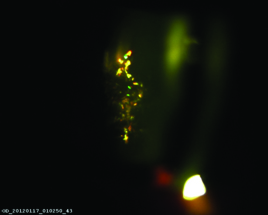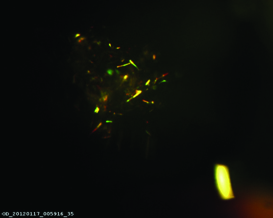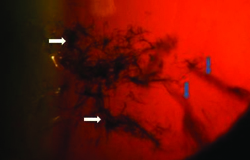Christmas Tree Cataract - A Cataract that Glitters
Tanie Natung1, Lanalyn Thangkhiew2, Avonuo Keditsu3, Wakaru Shullai4
1 Associate Professor, Department of Ophthalmology, North Eastern Indira Gandhi Regional Institute of Health & Medical Sciences (NEIGRIHMS), P.O. Mawdiangdiang, Shillong, Meghalaya, India.
2 Assistant Professor, Department of Ophthalmology, North Eastern Indira Gandhi Regional Institute of Health & Medical Sciences (NEIGRIHMS), P.O. Mawdiangdiang, Shillong, Meghalaya, India.
3 Senior Resident, Department of Ophthalmology, North Eastern Indira Gandhi Regional Institute of Health & Medical Sciences (NEIGRIHMS), P.O. Mawdiangdiang, Shillong, Meghalaya, India.
4 Senior Resident, Department of Ophthalmology, North Eastern Indira Gandhi Regional Institute of Health & Medical Sciences (NEIGRIHMS), P.O. Mawdiangdiang, Shillong, Meghalaya, India.
NAME, ADDRESS, E-MAIL ID OF THE CORRESPONDING AUTHOR: Dr. Tanie Natung, MD, North Eastern Indira Gandhi Regional Institute of Health & Medical Sciences (NEIGRIHMS), P.O. Mawdiangdiang, Shillong-793018, Meghalaya, India.
E-mail: natungtanie@gmail.com
A 54-year-old man presented to the Ophthalmology OPD with redness and discharge from his eyes. His vision was 20/20 in both the eyes. There was diffuse conjunctival congestion and mild discharge in both the eyes. On detailed examination, the left eye showed highly refractive, multi-coloured, iridescent crystals in the inferior cortex and nucleus of the crystalline lens. The colours changed with the change in the angle of the incident light. It was a spectacular display of different colours that glittered like an illuminated Christmas tree [Table/Fig-1,2]. The crystals cast thin and hairy shadows in retro-illumination ([Table/Fig-3] white arrows). There was an associated early cuneiform cataract inferiorly ([Table/Fig-3], blue arrows). A diagnosis of acute conjunctivitis in both eyes with a Christmas tree cataract (CTC) and early cuneiform cataract in the left eye was made. He was treated for the acute conjunctivitis with moxifloxacin 5% eyedrops (Vigamox, Alcon Laboratories Pvt. Ltd., Texus), 4 times a day for 1 week. The conjunctivitis got cured by 1 week. No treatment was required for the cataract since it was visually non-disturbing. Serum cholesterol, calcium, lipid profile and electromyogram were found to be within normal limits. Neurological consultation ruled out Myotonic dystrophy.
Anterior segment photograph of left eye (by slit lamp) showing highly refractive, multi-coloured, iridescent crystals in the inferior cortex and nucleus of the crystalline lens.

Anterior segment photograph (Magnified view, by slit lamp) of left eye showing the highly refractive, multi-coloured, iridescent crystals in the inferior cortex and nucleus of the crystalline lens.

Anterior segment photograph of left eye in retro-illumination showing the crystals casting thin and hairy shadows (white arrows) and associated early cuneiform cataract inferiorly (blue arrows).

CTC is a rare type of cataract. It varies from other cataracts that show some amount of different colours of the crystalline lens, like the posterior subcapsular cataract or the complicated cataract, in that it shows a spectacular display of multiple colours that glitters with the change of incident light like an illuminated Christmas tree. The exact cause for the mechanism of formation of CTC is not very clear. Different researchers have postulated different mechanisms for its formation. Pau and Forster were the first ones to suggest that the opacities seen in CTC were cholesterol crystals [1]. Hayes and Fisher subsequently postulated the diffraction of light from parallel sided stacks of fused cell membranes to be the cause for the striking polychromatic lustre [2]. As per Anders and Wollensak, the crystals were cholesterol in nature and were the result of lens metabolism [3]. According to Shun-Shin et al., CTC needles were most likely made of cystine due to an age-related aberrant breakdown of crystallins induced by elevated Ca++ levels [4]. Similarly, Obi and Weir postulated that CTCs resulted from the accelerated breakdown of membrane associated proteins and that excess cystine concentration lead to growing crystals [5]. Reiter and Gramer found Myotonic Dystrophy in 16.7% of patients with CTC [6].
Few other authors have also reported CTC but they have not postulated any cause for its formation. They have simply described their cases [7–9].
[Table/Fig-4] shows all the case reports on CTC so far from different parts of the world.
Case reports on Christmas Tree Cataract (CTC) from different parts of the world.
| Sl. No. | Authors | Year of Report | Postulation for the cause of CTC |
|---|
| 1. | Pau and Forster [1] | 1982 | Cholesterol crystals. |
| 2. | Hayes and Fisher [2] | 1984 | Diffraction of light from parallel sided stacks of fused cell membranes. |
| 3. | Anders and Wollensak [3] | 1992 | Cholesterol crystals; result of lens metabolism. |
| 4. | Shun-Shin et al [4] | 1993 | Cystine crystals; age-related aberrant breakdown of crystalline induced by elevated Ca++ levels; |
| 5. | Stevens and Swann [7] | 1998 | None; simple description of the case. |
| 6. | Reiter and Gramer [6] | 2009 | Found Myotonic Dystrophy in 16% cases of CTC. |
| 7. | Obi and Weir [5] | 2010 | Accelerated breakdown of membrane associated proteins; excess cystine concentration lead to growing crystals. |
| 8. | Zahir and Tahri [8] | 2014 | None; simple description of the case. |
| 9. | Stival et al [9] | 2015 | None; simple description of the two cases. |
| 10. | Present report (Natung et al.,) | 2016 | None; simple description of the case. |
To conclude, CTC is a rare cataract that may be found incidentally since it is visually non-disturbing, as is in our case. Its spectacular display of brilliance is very striking and evokes a ‘wow’ feeling in the person observing it. It is a wonder, how an illuminated Christmas tree like glittering can be found in the human body. This type of cataract is aptly called as the “Christmas tree cataract”.
[1]. Pau H, Forster H, Double refraction of crystals in the lens (spheroliths, “Christmas tree ornaments”) and in the vitreous body (scintillatio nivea) Graefes Arch Clin Exp Ophthalmol 1982 219:295-97. [Google Scholar]
[2]. Hayes BP, Fisher RF, Ultrastructural appearances of a lens with marked polychromatic lustre: evidence for diffraction as a cause Br J Ophthalmol 1984 68:850-58. [Google Scholar]
[3]. Anders N, Wollensak J, Christmas tree ornament cataract – an indication for disordered lipid metabolism? Klin Monbl Augenheilkd 1992 201:30-33. [Google Scholar]
[4]. Shun-Shin GA, Vrensen GF, Brown NP, Willekens B, Smeets MH, Bron AJ, Morphologic characteristics and chemical composition of Christmas tree cataract Invest Ophthalmol Vis Sci 1993 34:3489-96. [Google Scholar]
[5]. Obi EE, Weir C, A Christmas tree cataract BMJ 2010 341:c6644 [Google Scholar]
[6]. Reiter C, Gramer E, Anticipation in patients with iridescent multicoloured posterior capsular lens opacities (“Christmas tree cataract”): The Role in the diagnosis of myotonic dystrophy Ophthalmologe 2009 106:1116-20. [Google Scholar]
[7]. Stevens P, Swann PG, Christmas tree cataract Clin Exp Optom 1998 81:98-9. [Google Scholar]
[8]. Zahir F, Tahri H, A Christmas tree cataract Pan Afri Med J 2014 18:332 [Google Scholar]
[9]. Stival LRS, Bittar RHG, Lake AM, Junior LLN, Catarata em árvore de Natal Rev Bras Oftalmol 2015 74:309-11. [Google Scholar]